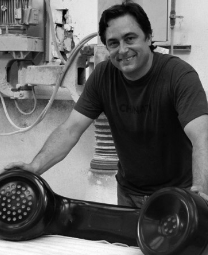Recent Press:
Daniel Henderson featured in Best Buy’s “Phone Innovators” ad for the 2012 Superbowl (created the ability to share video) Click here
”Populism, Technology and Interactivity,” New York Times
August 2011
read online PDF
Daniel A. Henderson’s Sculpture: Monuments for Contemplation on the Present
Essay by Robert C. Morgan
Click here to read the essay (PDF)
Memory Monuments: The Recent Sculptures of Daniel A. Henderson
Essay by Dominique Nahas
Click here to read the essay (PDF)
Public Radio interview
Geoffrey Riley of the Jefferson Exchange speaks with Daniel A. Henderson and art critic, Robert C. Morgan (Ashland, Oregon, Sept 2010)
Click here to listen
“Pushing Granite,” China Today, September 2010
Click here to read the article (PDF)
“Dan Henderson’s Amazing Sculptures” SOU Office of the President, October 2010
Click here to read the article
“Does Art Imitate Technology?,” US1, April 2011
Click here to read the article (PDF)
Gallery Representation:
Recent Exhibitions:
SELECT Fair, Chelsea NYC
May 2014
The Art of Invention at the
New Jersey Institute of Technology
October 1 – December 22, 2011
Grounds for Sculpture
May 1 – September 18, 2011
The Art of Invention: Sculpture by Daniel A. Henderson
Schneider Museum of Art at Southern Oregon University
September 30 – December 10, 2010
Daniel A. Henderson is a sculptor and inventor. His prototype wireless devices were received at the National Museum of American History at the Smithsonian Institution.
Henderson was assistant to Kazuo Hashimoto, the inventor of Caller ID and the modern answering machine, and also worked with Jack Kilby, inventor of the computer chip.
He founded a number of technology companies and was formerly with IBM.
His father, an artist and award-winning creative director, exposed Mr. Henderson to art early on. He spent his youth painting signs, sketching, wood working and restoring cars. This early interest in form and design and background as a technologist led to his focus on sculpture.
He is involved in numerous philanthropic efforts, including The Tech Museum of Innovation, The Cliburn Foundation and various educational institutions.
After an honorable discharge with the United States Marine Corps, Mr. Henderson earned two degrees from Southern Oregon University, where he also received the 1999 Distinguished Alumni award. Mr. Henderson also received an Honorary Doctor of Science degree from New Jersey Institute of Technology.
He resides in Fort Worth, Texas.

My art explores the viral allure of technology and its unintended consequences.
I am a sculptor and an inventor. Invention, like sculpture, is an artistic endeavor. Although the two disciplines utilize different mediums of expression, both share the ability to affect our perception and how we interact. My sculpture memorializes the impact that art and technology have on humanity.
In our lifetime, we have witnessed the birth of the microchip, the Internet, the ATM, video games, caller ID, the personal computer, the digital camera, and the portable cellular telephone. These ingenious machines and systems have conquered great human challenges, but not without unintended consequences.
In 2007, a prison guard utilized a cellular telephone to video the execution of Saddam Hussein, and it quickly spread across the world via the Internet, easily seen by our children. This event propelled me to think deeply about the use of technology and how it connects us interculturally yet somehow divides us interpersonally.
We should consider the ethics of products manufactured with toxic disposable materials. In a world of virtual reality with e-mail, text messaging, and Internet shopping, we are confronted with the decline in face-to-face communication, the erosion of community, and the expectation of instant gratification. I want people to talk about technology — rather than merely use technology to talk.
The scale of the sculpture both amplifies the form and functional design elements of the original objects while creating tension for the viewer unable to use them. The permanence of iconic products sculpted in stone represents the connection with the natural world and contrasts with the temporality of technology and the materials they are built from. The work is symbolic of the Art of Invention and the permanent alteration to the human landscape.
News
Biography
Artist's Statement
